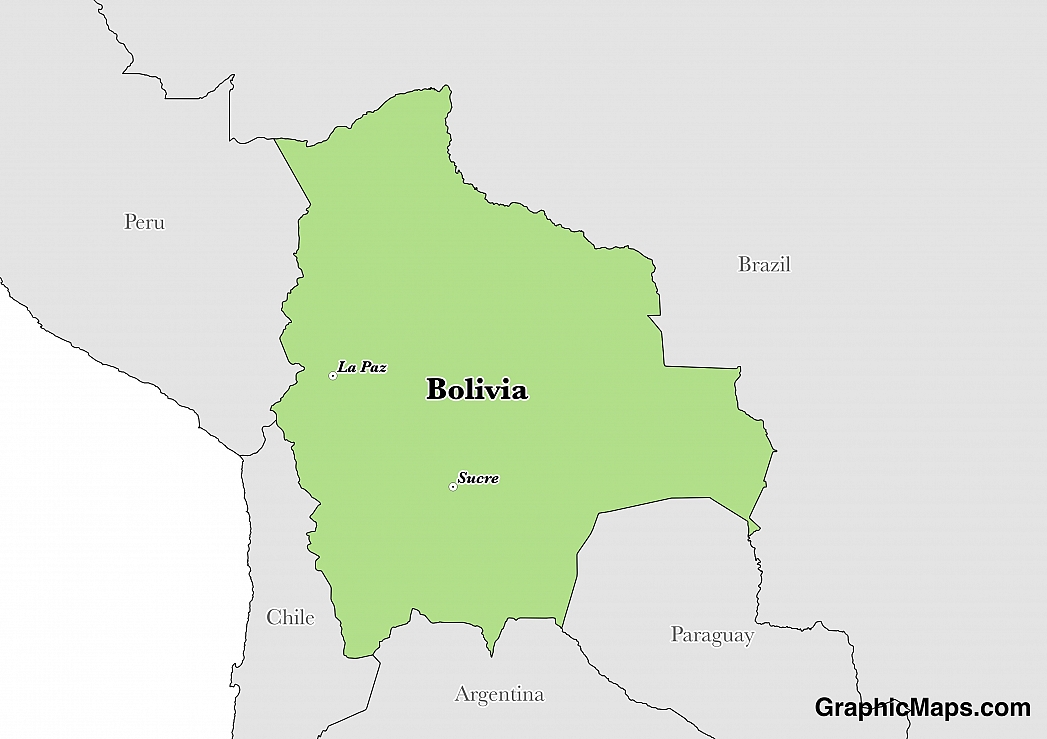Where is Bolivia?
Located in Central South America, Bolivia has a 7,252.00 km border with Argentina (942 km), Brazil (3,403 km), Chile (942 km), Paraguay (753 km) and Peru (1,212 km). Chile and Peru rebuff Bolivia's reactivated claim to restore the Atacama corridor.
Bolivia is often said to have 2 capital cities. The official capital, as named in the Constitution of the country, is Sucre. Today, this city serves as the seat of judicial power for Bolivia. The primary government seat is located in La Paz. These two cities are significantly different in population size. Sucre, for example, has a population of only around 300,000. La Paz, on the other hand, is the most populated city in the country with a metropolitan population of over 2.36 million. Both cities offer tourists a number of activities, ranging from historic buildings and museums to nearby hiking trails and beautiful landscapes.
Read more on Bolivia's CapitalBolivia is a South American country covering 1,098,581.00 km2 of which 1.39% is water and 1,083,301.00 km2 is land. This makes it the 27th largest country in the world and slightly less than three times the size of Montana. Its geographic coordinates are 17 00 S, 65 00 W and La Paz is the capital city.
The country is named after Simon Bolivar, a leader in the South American wars for independence.
Its ISO code is BO.
Geography
Bolivia has a mean elevation of 1,192 m above sea level.
Its climate varies depending on altitude, from humid and tropical at low altitudes to cold and semiarid at high altitudes. Its terrain consists of the rugged Andes Mountains with a highland plateau.
Population
Bolivia has a population of 10,969,649 making it the 81st largest in the world. The majority of the country lives in and around the city of Santa Cruz.
Spanish, Quechua, Aymara, and Guarani are all official languages. The majority ethnic group is mestizo. The population is mostly Roman Catholic.
The Constitution of Bolivia recognizes 37 official languages. Of these, Spanish is the most widely spoken, used by around 75% of the population as a native or second language. The remaining official languages of Bolivia are all considered Indigenous to the country. These Indigenous languages include Quechua, Aymara, and Guaraní. All levels of government in Bolivia are mandated to provide information to the public in 2 languages, Spanish and the language used by the local population. The Spanish spoken in Bolivia can be understood by Spanish speakers around the world, although it does enjoy some phrases that are unique to the area.
Read more on Bolivia's LanguagesThe dialing code for the country is 591.
Government
Bolivia is an independent country. It gained independence from Spain in 1825. Its constitution was last ratified in 2009.
The government of Bolivia is a representative democratic republic, in which the president serves as both the Head of Government and the Head of State. Presidents of Bolivia are limited to serve only 2 five-year terms during their lifetime, however, an amendment to the Constitution has allowed the current serving president to serve a third term. That amendment was overturned in 2016 by a general referendum. Legislative duties are carried out by the Plurinational Legislative Assembly in the National Congress building, located in La Paz. Voting in Bolivia is mandatory for citizens between 21 and 70 years of age or as early as 18, if married.
Read more on Bolivia's GovernmentEconomy
Factoring in Purchasing Power Parity, Bolivia's GDP is $78,660,000,000.00 (USD) with $7,200.00 (USD) per capita. This makes it the 93rd largest economy and its citizens the 150th richest in the world. The currency of Bolivia is the Boliviano (BOB).
Its major export partners are Brazil, Argentina, and the United States. Its main exports are natural gas, silver, zinc, and lead. Its major import partners are China, Brazil, and Argentina. Its major imports include machinery, petroleum products, and vehicles.
Flag
The current version of the flag of Bolivia has been in use since October of 1851. The flag of Bolivia has 3 horizontal stripes of equal measurement, beginning with red at the top, yellow in the middle, and green at the bottom. The national coat of arms is placed in the center of the yellow band. Each of the colors has a specific representation, as does the order of the colors. Bolivia celebrated Flag Day on August 17, 1825 to commemorate the first national flag that was flown after the country declared independence from Spain. The official flag description was set forth in the Supreme Decree of 1888, under President Gregorio Pacheco.
Read more on Bolivia's FlagThis page was last modified on January 17th, 2018
More on Graphicmaps

Published on 2019-11-06
What is a Trade Embargo?

Published on 2019-11-04
Which Two Countries Used to Have the Same Flag?

Published on 2019-09-16
What Is the Only Two-Sided State Flag?

Published on 2019-09-16
Which Country Flag Looks Like the Texas Flag?

Published on 2019-08-29
Flags That Resemble the US Flag

Published on 2019-08-20
